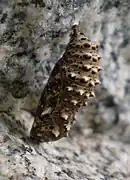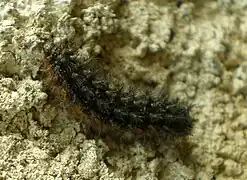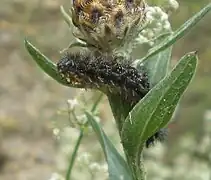Melitaea phoebe
Melitaea phoebe, the knapweed fritillary,[1] is a butterfly of the family Nymphalidae.[2] It is found in the Palearctic realm, except the northernmost locations. It used to include Melitaea telona, recently revalidated as a distinct cryptic species.
| Knapweed fritillary[1] | |
|---|---|
_underside_Bulgaria.jpg.webp) | |
| Male | |
 | |
| Female | |
| Scientific classification | |
| Domain: | Eukaryota |
| Kingdom: | Animalia |
| Phylum: | Arthropoda |
| Class: | Insecta |
| Order: | Lepidoptera |
| Family: | Nymphalidae |
| Genus: | Melitaea |
| Species: | M. phoebe |
| Binomial name | |
| Melitaea phoebe | |
| Synonyms[1] | |
|
Papilio phoebe Denis & Schiffermüller, 1775 | |
Description
The wingspan is 34–50 mm. M. phoebe. The largest Melitaea of the Old World, at least certain of its forms. The forewing much more pointed than in the previous species; equally variable in colour as well as the distinctness of the markings. The black markings are usually united, in some cases even covering nearly the whole wings, but in other cases may be strongly reduced. It is characteristic for this species that the reddish yellow submarginal lunate spot situated between the two median veins reaches with its vertex considerably farther into the disc than the other yellow lunate spots. This is especially the case on the forewing, but also on the hindwing the submarginal lunule between the 1. and 2. median veins projects farther basad than the others of the same row.[3] Wheeler (1903) gives a short description [4]
 Male
Male Male underside
Male underside Female
Female Female underside
Female underside
 Pupa
Pupa Larva
Larva Larva
Larva
Description in Seitz
phoebe. The largest Melitaea of the Old World, at least certain of its forms. The forewing much more pointed than in the previous species [M. aetherie]; equally variable in colour as well as the distinctness of the markings. The black markings are usually united, in some cases even covering nearly the whole wings, but in other cases may be strongly reduced. It is characteristic for this species that the reddish yellow submarginal lunate spot situated between the two median veins reaches willi its vertex considerably farther into the disc than the other yellow lunate spots. This is especially the case on the forewing, but also on the hindwing the submarginal lunule between the 1. and 2. median veins projects farther basad than the others of the same row. In Central and South Europe and North Africa, throughout northern Asia beyond the Chinese Sea to the east coast of . Japan. — The nymotypical phoebe Knoch (= corythallia Esp.) (65g) varies itself in size as well as colour. Beside uniformly dark specimens, like the male figured, there occur individuals in which both wings are traversed by a light yellow band which contrasts strongly with the reddish brown ground-colour. Sometimes the black colour of the basal area is dense, prominent and hardly interrupted by light spots, but reduced in the marginal area (= ab. geijeri Aign.), or in other aberrational specimens concentrated in large patches in the middle of the wing. On the whole the brightly variegated specimens occur more in the western and southern districts of the distribution area, the uniformly coloured and generally also large races in the east. But it happens also that a unicolorous form flies in the plains, while a brightly variegated one occurs in the neighbouring mountains. The largest races are known from East Asia, the smallest from North Africa. But there occur also dwarfed specimens in all other countries (= minor Frey, nana Stgr.). — occitanica Stgr. [M. p. ssp. occitanica Staudinger, 1871] {66a) is the most western form, particoloured, the light yellow median band contrasting with the red-brown ground. The submarginal band is broad and bright red-yellow, so that there is a superficial similarity to aurinia iberica from the same country ; but this form of phoebe shows distinctly the projecting lunule between the 1. and 2. median branch, the hindwing being also devoid of the black submarginal dots which are always distinct on the hindwing of iberica; South Spain. — In certain localities of the Central Alps, for instance at Zermatt, I met with a form in which light and dark macular bands regularly alternate; the spots at the margin, those of the median band and some in the cells are bright yellow, while the submarginal band and the bands across the apex of the cells are red- brown. This form therefore is very brightly variegated and I name it alternans subsp. nov.[now forma] — In Algeria flies a very small form, punica Oberth. [M. phoebe ssp. punica Oberthür, 1876](66a), which is evenly leather-yellow, the markings being close together and regular; only below the costa at the apex there are some small whitish spots. — In the form tatara Krulik., from Kasan, the black markings of the hindwing beneath are thicker and both wings bear a dark double line along the distal margin. — Whereas in tatara [M. phoebe ssp. tartara Krulikowsky, 1890] the ground-colour is more darkened above, it is of a pronounced bright and fiery tint in saturata Stgr.[M. phoebe ssp. saturata Staudinger, 1892, a large race from northern Central Asia. — tungana Bang-H. i. litt. [M. phoebe ssp. tungana Seitz, 1909 ] (65b) is again strongly darkened, the male being dark rownn above, the female black: fr the Sajan district. — caucasica Stgr.[ M. p. phoebe] , from the Caucasus and Armenia, is likewise a large race with the female strongly blackened, the light spots beyond the centre of the wing, however, are absent, the colour on the whole very bright, particularly beneath. — Greek specimens are paler yellow and more delicately spotted; ogygia Fruhst.[now species Melitaea ornata Christoph, 1893] — tungusa Herz [M. p. ssp. tungusa Herz, 1898 ] is considerably smaller, being likewise strongly darkened in the basal area of the wing, but pale-spotted beyond the centre of the wing; intermediate between the preceding form and the following one; from the Witu and Vilui Rivers in North-East Siberia. — ornata Christ.[full species see above] ogygia - M. p. phoebe, from the Ural, is one of the brightly variegated forms, the white markings alternating with the reddish yellow ground-colour. — aetherea Ev. (= aetheria Dup., melaina H.-Schaff.) [M. p. phoebe](66a) is a rather large form with very thin black markings, occurring from the mouth of the Danube through Anterior Asia to Turkestan, apparently particularly in the flat steppes, also in Algeria, for instance on the parade grounds at Constantine, at Batna, on the hills lying towards Festis, and in other places of North Africa. The upperside is almost uniformly bright reddish yellow, only the median band and the lunate spot between the 1. and 2. median veins being somewhat paler. — In telona Fruhst.][ Melitaea telona]] Fruhstorfer, 1908] Fruhst. the ground-colour is lighter, the black markings being thinner, more broken up, the underside paler yellow; Jerusalem. — scotosia Btlr [ now full species Melitaea scotosia Butler, 1878. (65h) closely agrees with the preceding form in colour, but the female as a rule — not always — has the black markings larger and more diffuse. Especially, however, is this form larger than all European ones; from Amurland, .North and Central China, Corea and .lapan. — Very large specimens, by far the largest known Melitaea of the Old World, have been separated as mandarina Stgr. [M. p. phoebe (65h)]; from Mongolia. — The form changaica Bang-H. i. litt.[M. p. ssp.changaica Seitz, 1909] (65h), from the Changai Mts. in .Mongolia, agrees with the previous in size, being of a deep colour, the female brightly variegated. — Larva grey, with red-brown, obtuse, soft, branched thorns, blackish dorsal lines and numerous small white granules; head black; otherwise similar to the larva of didyma. From the autumn until May on Centaurea. Pupa dull yellowish, with dark yellow and black markings. The butterflies are on the wing from June until August (in North Africa and the most southern districts of Europe already from April); they are fond of meadows and sunny slopes, but also occur frequently in stony places. They bask in the sun with the wings spread out, reposing on warm stones or on roads, and show a preference for thistles and scabious, on which latter they often sleep with closed wings at night and in dull weather. In Europe and the adjacent districts of Asia they are usually alnindant though local; the large forms of Eastern Asia occur more singly. [5]
Biology
The butterfly flies from April to September depending on the location. The larvae feed on Plantago and Centaurea species (including Centaurea jacea).
Etymology
Named in the Classical tradition.Phoebe is in Greek mythology is one of the first generation of Titans, who were one set of sons and daughters of Uranus and Gaia..
References
- Melitaea phoebe
- Savela, Markku. "Melitaea phoebe (Denis & Schiffermüller, 1775)". Lepidoptera and Some Other Life Forms. Retrieved 23 June 2018.
- Seitz. A. in Seitz, A. ed. Band 1: Abt. 1, Die Großschmetterlinge des palaearktischen Faunengebietes, Die palaearktischen Tagfalter, 1909, 379 Seiten, mit 89 kolorierten Tafeln (3470 Figuren)
 This article incorporates text from this source, which is in the public domain.
This article incorporates text from this source, which is in the public domain. - Wheeler, George.The butterflies of Switzerland and the alps of central Europe. London: Elliot Stock, 1903. pdf
- Seitz. A. in Seitz, A. ed. Band 1: Abt. 1, Die Großschmetterlinge des palaearktischen Faunengebietes, Die palaearktischen Tagfalter, 1909, 379 Seiten, mit 89 kolorierten Tafeln (3470 Figuren)
 This article incorporates text from this source, which is in the public domain.
This article incorporates text from this source, which is in the public domain.
